Hugh O'Flaherty, the genial Irishman from Killarney,
who became the Nazi's biggest problem in Rome.
Photo: Charles C. Fennel
Source: Scarlet Pimpernel of the Vatican by J.P. Gallagher
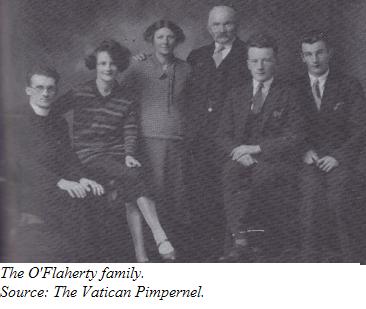
Hugh Joseph O’Flaherty was born on February 28th, 1898, in County Cork, Ireland. According to the custom of the time, his mother Margaret had returned to her family home of Lisrobin for the birth of Hugh, her first child. Margaret’s husband, James O’Flaherty, was a sergeant in the Royal Irish Constabulary, posted to Killarney, in County Kerry. This small and scenic Irish town was where Hugh, his brothers Jim and Neil, and his sister Bride would spend their childhoods.
It wasn’t the easiest time to grow up. Ireland was under the control of the British, denied “Home Rule,” or the right to form a government of its own. Any movement toward Irish independence was quickly and sometimes brutally suppressed by the British army forces that occupied the country. The most notorious of these was a group called the “Black and Tans,” which was primarily made up of petty criminals who’d shortened their prison sentences by agreeing to serve in the army. The members of the Royal Irish Constabulary had the awkward job of helping enforce the unpopular British policies. Eventually, like many of his colleagues, James O’Flaherty resigned rather than continue to be torn between duty and patriotism. All of these events made a deep impression on the young Hugh.
From his early teens, Hugh knew that he wanted to be a priest, and he attended a monastery school in Killarney and a Jesuit seminary in Limerick toward that end. He was rather better at sports than studying, however. After leaving the Constabulary, his father had become the caretaker for the Killarney Golf Club. The O’Flaherty family home bordered directly on the golf course, and young Hugh soon developed a passion for the game, along with other outdoor pursuits.
Hugh was also known for his fierce dedication to the Irish Nationalist cause. For him, as for many of his peers, it was not just a philosophical question. During the year of 1920, four of Hugh’s classmates were shot by the Black and Tans in four separate episodes. Hugh himself was once taken in for questioning simply because he’d attended the funerals of two other slain supporters of Irish independence. Every time Hugh and his student friends heard about more injustices like these, they would pound on their table in the refectory and roar, “One day we’ll sink the entire British navy!”
In 1922, Hugh went to Rome to complete his studies. He entered Urban College of the Congregation for the Propagation of the Faith, and amazed his former teachers by earning his theology degree in just one year. Hugh was ordained in 1925, and spent another two years at Urban College, serving as vice-regent and earning three doctorates in Divinity, Philosophy, and Canon Law.
In 1934, O’Flaherty was appointed a Monsignor. He traveled to Egypt as a secretary to Msgr. Torquato Dini, a diplomat of the Catholic Church; but Dini died suddenly while in service. O’Flaherty had to take over—and in the process, discovered that he possessed an enormous talent for diplomacy. This fact was not lost on his superiors. For the next four years, O’Flaherty was sent on diplomatic missions to places as diverse as San Domingo and Haiti (where he was decorated by the presidents of both islands for his work on famine relief), and Czechoslovakia (where the nature of his assignment has never been made clear, although it’s likely it had something to do with the hostility that was beginning to be obvious all throughout Europe). His work in all these matters must have been exemplary, for in 1938 he was recalled to Rome and appointed to the Holy Office. In 1922, Hugh went to Rome to complete his studies. He entered Urban College of the Congregation for the Propagation of the Faith, and amazed his former teachers by earning his theology degree in just one year. Hugh was ordained in 1925, and spent another two years at Urban College, serving as vice-regent and earning three doctorates in Divinity, Philosophy, and Canon Law.
In 1934, O’Flaherty was appointed a Monsignor. He traveled to Egypt as a secretary to Msgr. Torquato Dini, a diplomat of the Catholic Church; but Dini died suddenly while in service. O’Flaherty had to take over—and in the process, discovered that he possessed an enormous talent for diplomacy. This fact was not lost on his superiors. For the next four years, O’Flaherty was sent on diplomatic missions to places as diverse as San Domingo and Haiti (where he was decorated by the presidents of both islands for his work on famine relief), and Czechoslovakia (where the nature of his assignment has never been made clear, although it’s likely it had something to do with the hostility that was beginning to be obvious all throughout Europe). His work in all these matters must have been exemplary, for in 1938 he was recalled to Rome and appointed to the Holy Office.
The Holy Office (now the Congregation for the Doctrine of the Faith) is the supreme court of the Catholic Church. Its officials deal with challenges to the Faith, handle controversies over the Church’s doctrines and teachings, and examine claims of visions and miracles. As an organization, the Holy Office dates back to 1560—when it was known as the Inquisition. It was here that O’Flaherty would spend his career, starting as Scrittore, or Writer, and rising to the position of Primo Notario, or Head Notary, the official who draws up the final drafts of all the decisions and signs them.
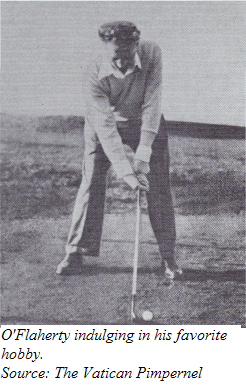 O’Flaherty’s work was very important to him. So was his golf game. He
was Italy’s amateur golfing champion (never mind that there were
diocesan regulations against priests playing golf). He was also a
superb boxer, played a good game of handball, and was a decent hurler.
Six-foot-two, raw-boned and strong, with cheap wire-rimmed glasses and
an Irish brogue, O’Flaherty did not look, or act, like a typical
cultured Church official. But Roman high society was crazy over him.
He regularly golfed with Mussolini’s son-in-law, and with the former
king Alfonso of Spain. He was invited to all the best parties. He knew
everyone, and everyone knew him. And they adored him. Some of
O’Flaherty’s colleagues in the Church raised their eyebrows over his
behavior, but others appreciated his unique gifts, and used him as a
sort of unofficial ambassador in many confidential matters.
O’Flaherty’s work was very important to him. So was his golf game. He
was Italy’s amateur golfing champion (never mind that there were
diocesan regulations against priests playing golf). He was also a
superb boxer, played a good game of handball, and was a decent hurler.
Six-foot-two, raw-boned and strong, with cheap wire-rimmed glasses and
an Irish brogue, O’Flaherty did not look, or act, like a typical
cultured Church official. But Roman high society was crazy over him.
He regularly golfed with Mussolini’s son-in-law, and with the former
king Alfonso of Spain. He was invited to all the best parties. He knew
everyone, and everyone knew him. And they adored him. Some of
O’Flaherty’s colleagues in the Church raised their eyebrows over his
behavior, but others appreciated his unique gifts, and used him as a
sort of unofficial ambassador in many confidential matters.
The Storm Begins.
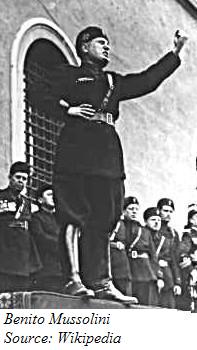 The year 1939 saw two events that would have stood out in importance in
O’Flaherty’s mind. In March, Cardinal Pacelli was crowned Pope Pius
XII. And in September, World War Two began. The Nazis invaded Poland.
Britain and France declared war on Germany in return. Ireland remained
neutral—with an army of only seven thousand men, and a navy that
consisted of two ships, its position was extremely precarious. But
Italy’s Fascist leader, Benito Mussolini, was confident of his own
country’s strength. He had signed a “Pact of Steel” with Adolf Hitler;
once Germany went to war, Italy was bound to follow. On June 10, 1940,
Italy declared war on France and Britain. O’Flaherty, doubly neutral as
an Irishman and a priest, found himself in the middle of a war zone.
But he was in the middle of it in a very special way.
The year 1939 saw two events that would have stood out in importance in
O’Flaherty’s mind. In March, Cardinal Pacelli was crowned Pope Pius
XII. And in September, World War Two began. The Nazis invaded Poland.
Britain and France declared war on Germany in return. Ireland remained
neutral—with an army of only seven thousand men, and a navy that
consisted of two ships, its position was extremely precarious. But
Italy’s Fascist leader, Benito Mussolini, was confident of his own
country’s strength. He had signed a “Pact of Steel” with Adolf Hitler;
once Germany went to war, Italy was bound to follow. On June 10, 1940,
Italy declared war on France and Britain. O’Flaherty, doubly neutral as
an Irishman and a priest, found himself in the middle of a war zone.
But he was in the middle of it in a very special way.The State called Vatican City.
The Vatican City, where O’Flaherty lived and worked, is the spiritual and physical capital of the Roman Catholic Church. It traces back to the fourth century A.D., when a basilica was built to honor the tomb of the Apostle Peter. During the 1300’s, the popes began to take up residence in palaces around the basilica. Vatican City became the seat of the Holy See, the central government of the Catholic Church. At first, the pope ruled the Vatican like a monarch. But as the various Italian cities and states unified into the country of Italy during the 1860’s and ‘70’s, the question arose: who would have control over Vatican City, the pope or the new Italian government? And if the pope is to be the spiritual leader of a worldwide body, what should be his relationship to secular governments? These questions had only been settled within O’Flaherty’s lifetime. In 1929, Mussolini and Cardinal Gasparri signed the Lateran Treaty, which recognized the “absolute and visible independence” of the pope and gave him “sovereign jurisdiction” over Vatican City and a few other properties owned by the Church. The Vatican would become an independent country, with its own laws, its own money, and its own court system. It would not be subject to Italian regulations or taxes. In return, the Holy See promised not to get involved in the politics of Italy, and to maintain absolute neutrality in all international affairs. This treaty was only a decade old at the outbreak of World War Two.The White Line.
In accordance with the Lateran Treaty, the Vatican remained neutral when war was declared. But it was a tiny island of neutrality—the Vatican covers only 0.44 square kilometers (108.7 acres), and is completely surrounded by the city of Rome. It does not even have its own water supply; every necessity has to come through Rome. When Italy went to war in 1940, the Vatican was effectively isolated in Fascist territory. In this position, it was vulnerable to the decisions of Mussolini and Hitler, but it was equally as vulnerable to British and American bombing raids.Halfway through the war, the Germans had a white line painted on the cobbles across the opening of St. Peter’s Square. This was ostensibly to keep Axis troops out and show them where their jurisdiction ended—but some also saw it as a way to keep Vatican members in, and show them where their neutral privileges ended. Whatever the case, it was a very literal expression of the figurative fine line the Vatican’s citizens had to walk during the war.
"God's Traveler."
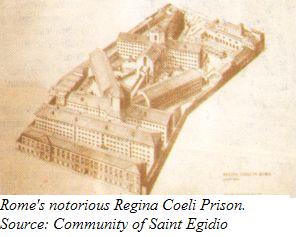 The war, from the beginning, created a huge number of homeless,
displaced, missing, and imprisoned persons. At the same time, the war
prevented the Holy Office from doing its usual business. So it was
decided that the Office should handle the refugee issues. One Msgr.
Bergoncini Duca was appointed to be the Pope’s messenger to the many
prisoner-of-war camps scattered throughout Northern Italy. Tagging
along as secretary and interpreter was Hugh O’Flaherty.
They started their tour of the camps on Easter, 1941. Msgr. Duca’s
style was to set a stately pace, inspecting one camp a day, spending the
evenings at hotels. O’Flaherty’s style was to spend hours talking with
the prisoners, then, at night, travel back to Rome by a fast train. He
would relay messages from the prisoners to his friend Father Owen
Sneddon, who worked at the Vatican’s radio station. Sneddon would
broadcast the information so the prisoners’ families would know they
were alive. Meanwhile O’Flaherty would rush back to join Duca at
another camp.
Somewhere O’Flaherty also found the time to arrange for warm clothing to
be delivered to the camps in time for the cold Northern Italian winter.
He collected and distributed an estimated ten thousand books for the
prisoners—and didn’t let official camp censors stand in his way. When
bureaucracy held up the delivery of Red Cross packages, O’Flaherty
blatantly cut through red tape and regulations until the parcels reached
the prisoners. The camps at Modena and Piacenza were very badly run;
with a word in the right ear, O’Flaherty managed to get both camps’
commandants fired. A visit from O’Flaherty, the authorities found,
would raise the prisoners’ spirits, and lower the morale of the guards.
The war, from the beginning, created a huge number of homeless,
displaced, missing, and imprisoned persons. At the same time, the war
prevented the Holy Office from doing its usual business. So it was
decided that the Office should handle the refugee issues. One Msgr.
Bergoncini Duca was appointed to be the Pope’s messenger to the many
prisoner-of-war camps scattered throughout Northern Italy. Tagging
along as secretary and interpreter was Hugh O’Flaherty.
They started their tour of the camps on Easter, 1941. Msgr. Duca’s
style was to set a stately pace, inspecting one camp a day, spending the
evenings at hotels. O’Flaherty’s style was to spend hours talking with
the prisoners, then, at night, travel back to Rome by a fast train. He
would relay messages from the prisoners to his friend Father Owen
Sneddon, who worked at the Vatican’s radio station. Sneddon would
broadcast the information so the prisoners’ families would know they
were alive. Meanwhile O’Flaherty would rush back to join Duca at
another camp.
Somewhere O’Flaherty also found the time to arrange for warm clothing to
be delivered to the camps in time for the cold Northern Italian winter.
He collected and distributed an estimated ten thousand books for the
prisoners—and didn’t let official camp censors stand in his way. When
bureaucracy held up the delivery of Red Cross packages, O’Flaherty
blatantly cut through red tape and regulations until the parcels reached
the prisoners. The camps at Modena and Piacenza were very badly run;
with a word in the right ear, O’Flaherty managed to get both camps’
commandants fired. A visit from O’Flaherty, the authorities found,
would raise the prisoners’ spirits, and lower the morale of the guards.
After half a year of this, J.P. Gallagher writes, “the Italian Government decided it was time this pest was kept out of their POW camps.” Bureaucratic pressure was brought to bear on Vatican officials. By December of 1942, O’Flaherty was instructed to resign his work in the camps. In obedience to his superiors, the monsignor returned to Rome. But not before he had drawn attention on many levels. Michael MacWhite, the Irish envoy to Italy, even mentioned O’Flaherty in one of his dispatches back to Dublin: “It would not surprise me if he found himself in a concentration camp one of these days …”
The First Rescues.
As it turned out, it was a good thing O’Flaherty came back to Rome when he did. Mussolini and the Germans were beginning to crack down on those Roman citizens they felt were dangerous or undesirable. Their targets included prominent Jews, well-known anti-Fascists, and Italian aristocrats who were vocal in their opposition to the regime. O’Flaherty knew many of these people. They were the society he had socialized with before the war. And when they found themselves in danger, it’s not surprising that the first person they thought of turning to was the Irish priest. O’Flaherty began by asking some of his friends who were not under scrutiny to open their homes to those of his friends who were. Then he began sending people to monasteries or convents for refuge. As the Fascist raids became more dangerous, O’Flaherty started bringing people directly into Vatican City.One of the first of these was Princess Nini Pallavicini, a young widow from one of Rome’s oldest aristocratic families. She had been discovered operating an illegal radio and had only escaped arrest by jumping out a window. O’Flaherty found a room for her in his own place of residence, a building known as the “German College,” because it had traditionally housed German religious scholars, and was staffed by German nuns. O’Flaherty had lived there since the beginning of his Vatican career, and had developed a great admiration for the German people and their culture—he even did his best to learn their language, although he never spoke it as well as he did French and Italian. It is, of course, an enormous irony that thanks to O’Flaherty, the German College would keep many of its country’s “enemies” safe for the duration of the war.
Another group who knew O’Flaherty and was inclined to come to him for help were the prisoners-of-war who had met the priest during his visits to the camps. Any POWs who managed to escape tended to head for Rome, in search of the British embassy. St. Peter’s Basilica was an inviting destination too; surely the church had to offer shelter to anyone who asked?
The Vatican was doing what it could. All the diplomats from the countries now considered Italy’s enemies had been moved into the Vatican. Some 477 Jews would be sheltered in the Vatican throughout the war, and other early refugees found sanctuary there as well. But 0.44 square kilometers can only hold so many people, and the Nazis were keeping a close eye on Vatican activity. By the beginning of 1943, the Swiss Guard, the Vatican’s police force, was ordered to turn asylum-seekers away. One such group of British escapees was standing bewildered in the middle of St. Peter’s Square when someone brought them to O’Flaherty’s attention. The Irishman arranged to have them hidden in the barracks of a sympathetic Italian police brigade. It was all in a day’s good work for O’Flaherty. He probably had no idea what he had started.
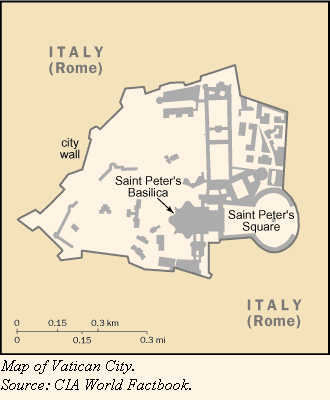
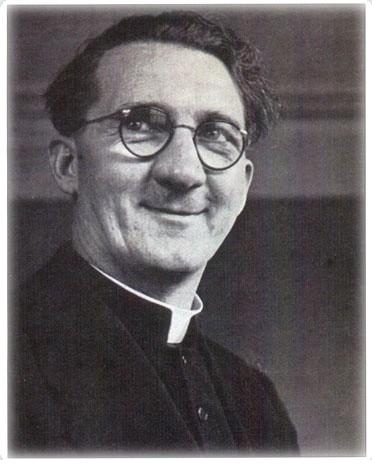
Enemies.
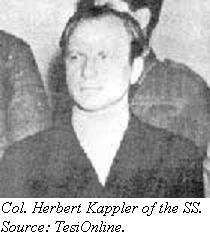 On July 19, 1943, the Allies bombed Rome. The Italian Fascist
administration crumbled, and Mussolini was arrested. By September 8,
surrender to the Allies had been arranged. Prisoners-of-war began to
pour out of the now-unguarded camps, and head in droves to Rome. But
they were premature. Between September 11th and 23rd, the Germans
occupied Rome, rescued Mussolini, and set up a military government. The
danger was greater than ever. And there were two men in particular to
be very frightened of.
One was Colonel Herbert Kappler. Born in Stuttgart, Germany, he had
risen through the ranks of the SS, and had won his superiors’ admiration
for his brutal suppression of the Belgian resistence during the early
stages of the war. He was now appointed Head of the Gestapo in Rome.
One of his first acts was to demand a ransom of two million pounds of
gold from the Jews of Rome—if it was not paid, they would be deported to
Germany. With the help of many Italians, the amount was raised. But
the deportation went ahead anyway, supervised by Kappler. Some 1,000
Jews were sent to Auschwitz. About 16 survived.
On July 19, 1943, the Allies bombed Rome. The Italian Fascist
administration crumbled, and Mussolini was arrested. By September 8,
surrender to the Allies had been arranged. Prisoners-of-war began to
pour out of the now-unguarded camps, and head in droves to Rome. But
they were premature. Between September 11th and 23rd, the Germans
occupied Rome, rescued Mussolini, and set up a military government. The
danger was greater than ever. And there were two men in particular to
be very frightened of.
One was Colonel Herbert Kappler. Born in Stuttgart, Germany, he had
risen through the ranks of the SS, and had won his superiors’ admiration
for his brutal suppression of the Belgian resistence during the early
stages of the war. He was now appointed Head of the Gestapo in Rome.
One of his first acts was to demand a ransom of two million pounds of
gold from the Jews of Rome—if it was not paid, they would be deported to
Germany. With the help of many Italians, the amount was raised. But
the deportation went ahead anyway, supervised by Kappler. Some 1,000
Jews were sent to Auschwitz. About 16 survived. Later in the war, Communist resistance fighters set off a bomb that killed 32 German soldiers. In retaliation, Kappler chose ten Italians for every German killed, marched them to the Ardeatine Caves at Domitilla, and machine-gunned them down. When the shooting was finished, the entrances to the caves were blown up, sealing the victims, whether dead or wounded, behind tons of rock.
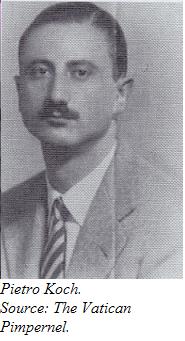 Then there was Pietro Koch. An Austrian by birth, he was head of
interrogation for both the Italian Fascists and the Gestapo, and was
known as “an acknowledged master of tortures both crude and refined.”
Gallagher describes a few of Koch’s methods: sometimes he would strap
the subject into a leather belt studded with narrow steel spikes, and
slowly tighten it. Another trick was to systematically file to the
subject’s teeth down to the sensitive roots. Undeniably a sadist, Koch
liked to supervise SS torture sessions and was probably the most hated
person in Rome.
Then there was Pietro Koch. An Austrian by birth, he was head of
interrogation for both the Italian Fascists and the Gestapo, and was
known as “an acknowledged master of tortures both crude and refined.”
Gallagher describes a few of Koch’s methods: sometimes he would strap
the subject into a leather belt studded with narrow steel spikes, and
slowly tighten it. Another trick was to systematically file to the
subject’s teeth down to the sensitive roots. Undeniably a sadist, Koch
liked to supervise SS torture sessions and was probably the most hated
person in Rome. Friends.
These, then, were the kind of men that O’Flaherty was up against, if he was determined to stand for humanity. And the numbers of those in danger was rising daily. O’Flaherty decided to ask for help. The first person he approached, although a logical choice, was not someone O’Flaherty would normally befriend: Sir Francis Godolphin D’Arcy Osborne was an English gentleman, cousin to the Duke of Leeds, and British Minister to the Holy See. Since most of the escaped POWs were British, O’Flaherty assumed that Sir D’Arcy would want to do something. The Minister thought the whole situation was “acutely embarrassing for His Majesty’s Government,” but unfortunately he could not risk compromising the Vatican’s neutrality. One can imagine O’Flaherty’s Irish blood was close to boiling after this speech. But D’Arcy wasn’t finished; he suggested the priest have a “quiet chat” with the Minister’s butler, a small, inscrutable Cockney named John May. “I don’t want to know any details,” J.P. Gallagher has the Minister say, “but I have a good idea he can help you!”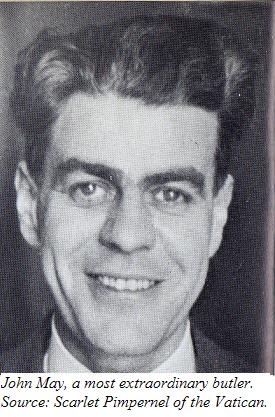 John May, O’Flaherty would later say, was a special kind of genius: “the
most magnificent scrounger I have ever come across.” May had an
incredible talent for obtaining things that weren’t supposed to be
obtainable. Did the escapees need shoes or clothing, no questions
asked? Not a problem. Did they need more food than wartime rationing
allowed? John May could get it. Like O’Flaherty, May had friends
everywhere, particularly in the black market. Numerous useful people
owed him favors. As shrewd and careful as O’Flaherty was large-hearted
and innocent, John May proved to be the perfect counterpart to the
Monsignor.
John May, O’Flaherty would later say, was a special kind of genius: “the
most magnificent scrounger I have ever come across.” May had an
incredible talent for obtaining things that weren’t supposed to be
obtainable. Did the escapees need shoes or clothing, no questions
asked? Not a problem. Did they need more food than wartime rationing
allowed? John May could get it. Like O’Flaherty, May had friends
everywhere, particularly in the black market. Numerous useful people
owed him favors. As shrewd and careful as O’Flaherty was large-hearted
and innocent, John May proved to be the perfect counterpart to the
Monsignor. Also involved was Count Sarsfield Salazar of the Swiss Legation, very helpful in procuring neutral Swiss identity papers and oiling diplomatic wheels. Thomas Kiernan, the Irish ambassador to the Vatican, had to adhere strictly to his country’s policy of neutrality, but his wife, the noted singer Delia Murphy, had a freer hand and helped where she could—seeing that O’Flaherty had the use of the Irish Legation’s car when he needed it, for example. Molly Stanley, a middle-aged English governess, was another good friend of O’Flaherty’s who turned out to be a tireless worker on his behalf. She had lived in Rome since her early twenties, and her insider’s knowledge of the city was invaluable. Behind the scenes, Sir D’Arcy quietly supplied money. With these people aiding O’Flaherty, the rescue effort started to take on the appearance of an organization.
A Heroic Lady.
One of the organization’s first and best-loved collaborators was woman named Henrietta Chevalier. The Chevaliers were from Malta, a tiny British-owned island in the Mediterranean. Mrs. Chevalier was a widow. Her oldest son, being officially a British subject, had been put in prison at the beginning of the war. Her second son, a clerk at the Swiss Legation, was sheltering there; her youngest daughter had been sent to a convent. Mrs. Chevalier, her elderly mother and her five other daughters lived on a small pension in a third-floor apartment on the Via Dell’ Impero. When a couple of escaped POWs needed an emergency hiding-place one day, a priest mentioned Mrs. Chevalier to O’Flaherty—only as a temporary solution, of course. Private citizens would be executed if caught sheltering refugees. But the five-foot-four Mrs. Chevalier was not easily frightened. She took in those two refugees, and would host escaped soldiers throughout the war, sometimes as many as nine at a time in her two-bedroom apartment. If the accommodations were lacking in space, Mrs. Chevalier’s cooking more than compensated. Her daughters, ages twenty-one through thirteen at the time, were in charge of shopping and running errands, and keeping the escapees entertained. They recall playing gramophone records with the soldiers, and showing them around the sights of Rome, once the men had received forged papers that made it somewhat safe to go out. War or no, everyone managed to have fun.The danger, however, was very real. SS troops would often conduct surprise raids of suspected properties. Several times, sympathetic neighbors warned the Chevaliers to send their soldiers out for a long walk and tidy away the extra mattresses and plates. Soon, rifle butts would crash against the door, troopers would march in, and the apartment would be thoroughly searched. Mrs. Chevalier would be calm, on one occasion sitting and darning socks for “her boys.”
Casting Bread on the Waters.
The organization was getting the hang of things now. Refugees would make their way to the Vatican or be referred there by sympathetic Italians. O’Flaherty and May would find places for them in monasteries, hotels, or warehouses, and in private homes like Mrs. Chevalier’s, under the care of friendly Italian padrones, or patrons. When more space was needed, O’Flaherty began to rent properties of his own—such as the luxury apartment on the Via Firenze, which backed directly onto a hotel used by the Gestapo! Food and supplies were found by May. A circle of priests would deliver the supplies to the various billets every day, check up on the refugees’ welfare, and bring warnings if it were necessary to vacate the premises. In the middle of it all was O’Flaherty, ubiquitous Irish twinkle in his eyes, calmly doing whatever needed to be done while showing a complete disregard for the official curfew, the Fascist troops in the streets, the disapproval of Church officials, or anything else that might slow him down. But perhaps what O’Flaherty was most known for disregarding were the distinctions that usually get drawn between different groups and nationalities during wartime. He would honestly help anyone who needed it. An old granary on the Vatican grounds once held a typical mix of refugees: fifteen American civilians unable to get home, one American GI, two American airmen, eight British soldiers, one Irish Guardsman, several political fugitives, a Protestant clergyman from South Africa, and an Italian pilot who’d had to disappear because he’d flown Italian top brass to the surrender meeting. Communists from Yugoslavia showed up at the Vatican’s gates. So did Arabs who had been captured during Italy’s campaign in North Africa. O’Flaherty did what he could for them all.It took a lot to make the monsignor choose sides. At the beginning of the war, O’Flaherty, with his childhood memories of British oppression, was often heard to say that he saw no real difference between the British and the Germans. “I used to listen to broadcasts from both sides,” he told a friend later, “All propaganda, of course, and both making the same terrible charges against the other. I frankly didn’t know which side to believe—until they started rounding up the Jews in Rome. They treated them like beasts, making old men and respectable women get down on their knees and scrub the roads. You know the sort of thing that happened after that…” Once he saw this, O’Flaherty came down on the side of the Allies. And in another of the great paradoxes of the Monsignor’s life, he, who had been so anti-British as a youth, actually ended up rescuing more British POWs in Italy than anyone else.
A Cheeky Priest.
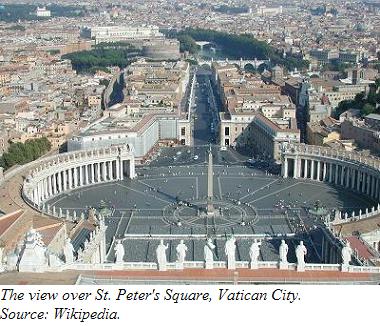 Of course, O’Flaherty’s organization was not the only one hiding and
aiding refugees in Rome. But as William Norman Grigg writes in The New
American, “What distinguished O'Flaherty from his colleagues was his
audacity.” Almost every evening, O’Flaherty would stand on the top step
of St. Peter’s, in full view of the SS troops patrolling the white
boundary line. He was saying his prayers, but he was also waiting for
anyone in need to approach him.
He had numerous tricks for smuggling people in or out of the Vatican.
Sometimes he disguised them in his own monsignorial robes. One young
lady was dressed up in a Swiss Guard uniform and marched right through.
O’Flaherty himself moved pretty openly through Rome, calling on
friends, collaborators and supporters, collecting money or supplies,
visiting hospitals and the notorious Regina Coeli prison. “He used to
play games with the Germans,” recounted one of the rescued POWs, Major
William Simpson, in his book, A Vatican Lifeline. “It was the most
gigantic game of hide-and-seek you've ever seen.”
Of course, O’Flaherty’s organization was not the only one hiding and
aiding refugees in Rome. But as William Norman Grigg writes in The New
American, “What distinguished O'Flaherty from his colleagues was his
audacity.” Almost every evening, O’Flaherty would stand on the top step
of St. Peter’s, in full view of the SS troops patrolling the white
boundary line. He was saying his prayers, but he was also waiting for
anyone in need to approach him.
He had numerous tricks for smuggling people in or out of the Vatican.
Sometimes he disguised them in his own monsignorial robes. One young
lady was dressed up in a Swiss Guard uniform and marched right through.
O’Flaherty himself moved pretty openly through Rome, calling on
friends, collaborators and supporters, collecting money or supplies,
visiting hospitals and the notorious Regina Coeli prison. “He used to
play games with the Germans,” recounted one of the rescued POWs, Major
William Simpson, in his book, A Vatican Lifeline. “It was the most
gigantic game of hide-and-seek you've ever seen.”O’Flaherty was actually a fairly distinctive figure, given his height, his glasses, and the wide-brimmed hat and red-and-black cassock he wore as a monsignor. But he was not above disguising himself. Sometimes he would put on the uniform of a postman or a street cleaner; other times, he would go out in the clothes of a simple laborer. There is even a story that he occasionally dressed up as a nun. For years before the war, O’Flaherty had made a habit of saying a very early Sunday morning mass, which was largely attended by the men who ran Rome’s trolley-system, since their schedule prevented them from going to other services. The friendship and gratitude of these trolley men turned out to be extremely helpful, later, when O’Flaherty needed to move himself and his refugees around Rome.
O’Flaherty was almost never intimidated by his task, and almost always optimistic. One evening, a Jewish couple approached him on the steps of St. Peter’s. They expected to be deported any day, and were resigned to their fate. They asked only that O’Flaherty save their seven-year-old son, and offered the priest a long, solid gold chain in payment. O’Flaherty took the chain, hid the boy safely, and obtained forged identity papers for the couple that allowed them to survive the occupation. At the end of the war, O’Flaherty reunited the parents with their son—and their gold chain. He had kept it in a desk-drawer in his room the entire time. When appalled colleagues asked him why he was being so careless with something so valuable, O’Flaherty shrugged: “Nobody here will steal it.”
Everything O’Flaherty did seemed to have a certain style to it. Once, a man he had hidden in Urban College developed appendicitis. O’Flaherty borrowed a car from an important Vatican official and drove the man to Santo Spirito Hospital, where it was arranged that the nuns would quietly add the man to the surgery list. He was operated on by a German military surgeon, recovered in a ward full of German officers, and was taken back to the College by O’Flaherty.
Luck of the Irish.
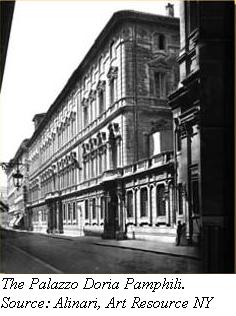 It was probably this attitude of O’Flaherty’s that made Colonel Kappler
so determined to catch the Irishman. The SS had strong suspicions of
his activities. But because O’Flaherty was protected by Vatican
neutrality, they couldn’t simply arrest and interrogate him; they needed
solid proof. Kappler also needed to catch the priest outside that
white line. One day it looked as though he had succeeded.
It was probably this attitude of O’Flaherty’s that made Colonel Kappler
so determined to catch the Irishman. The SS had strong suspicions of
his activities. But because O’Flaherty was protected by Vatican
neutrality, they couldn’t simply arrest and interrogate him; they needed
solid proof. Kappler also needed to catch the priest outside that
white line. One day it looked as though he had succeeded.One of O’Flaherty’s aristocratic friends, Prince Filipo Doria Pamphili, had been supporting the organization with donations of cash. This morning, O’Flaherty had come to pick up the money. But Kappler had the Palazzo Doria under surveillance. Just as O’Flaherty was about to leave, the Prince’s secretary happened to look out the window. The street had been blocked off, SS troops were surrounding the Palazzo, and Kappler himself was getting out of his car to supervise the search. This was it, Prince Filipo said. Time to give up. O’Flaherty didn’t agree. If he could just get himself and the money safely out of the Palazzo, the Germans would have no proof, Prince Filipo wouldn’t be compromised, and everything could keep going.
So as the SS men thundered into the Palazzo, O’Flaherty dived down into the cellars. The act gained him a few moments to think. He noticed a strange rumbling noise. One of the cellars had a chute that opened onto the courtyard above. At the moment, coal was being poured down the chute. O’Flaherty risked a look. Two coalmen were worriedly watching the SS men. O’Flaherty snuck an empty coal sack down into the cellar, pulled off his robe and hat, stuffed them into the sack, and covered his shirt and face with coal dust.
Then he waited until one of the coalmen was right above the chute. O’Flaherty warned him in a whisper, and asked him to hide in the chute while the priest took his place. The man agreed and a few minutes later, O’Flaherty was carrying his sack past two lines of SS men. They moved out of his way so he didn’t get their uniforms dirty. Once the coal truck blocked him from view, he took off down the street.
The coalmen finished their delivery and left, unmolested, while the search moved to the roof. O’Flaherty ducked into the nearest church, washed up in the vestry and resumed his hat and robe. Then he walked unchallenged back to the Vatican. Colonel Kappler spent two hours at the Palazzo Doria, but was forced to leave empty-handed—and very angry.
Narrow Escapes and Escapades.
O’Flaherty wasn’t the only one with stories like that to tell. When SS troops arrived one day for another raid on the Chevalier’s apartment block, the five escapers billeted there had no time to get away. In desperation, they went out onto the balcony and lowered themselves over the edge, clinging to the railings underneath. As it turned out, the troops searched a neighboring apartment, and fortunately never thought to look overhead as they left! And then there was the time when two British Lieutenants were out at the opera with their padrones, Renza and Adrienne Lucidi. Occupying the box next to them was the German general who’d just been appointed Military Governor of Rome. As the opera went on, it became obvious that the General was admiring the beautiful Mrs. Lucidi. Amused, her husband suggested she ask the General for his autograph. She did so, and the delighted General signed his name across her program. The next day, the Lieutenants gleefully brought the paper to the Vatican: an authentic signature from the man who was the absolute top authority in Rome! A legend arose that the organization used this signature on the counterfeit passports that John May (who had photography and forgery on his interesting list of skills) helped provide for refugees. In fact, they simply kept it in case they needed it.“S. Derry, Major.”
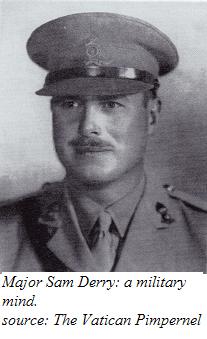 The organization was obviously the place for people with a bold turn of
mind. In late October 1943, another of these showed up. Major Sam
Derry of the Royal Artillery had been captured in North Africa, taken to
Italy, and put on a prison train heading to Germany. He’d jumped to
freedom and headed for the hills, where he found himself in charge of a
motley group of POWs about 120 miles behind enemy lines. Since winter
was coming on, Derry wrote a letter to the Vatican, asking for money and
clothing. A friendly priest took the message, and returned with 3,000
lire and a request that Derry provide a receipt. Derry duly wrote out
an acknowledgement of the money, signed it “S. Derry, Major,” and
included a p.s. asking for more! These communications reached
O’Flaherty, who liked their tone. He and D’Arcy had been looking for
someone to bring a little discipline to the growing numbers of escaped
soldiers. Derry was brought to Rome in the back of a farmer’s cabbage
cart and sneaked into the Vatican—at six-foot-three, he was a good fit
for O’Flaherty’s robes. The Monsignor and Sir D’Arcy liked what they
saw, and Derry officially became a compatriot.
Derry’s military mind brought some order and security to the
organization. He started to list names and next-of-kin for the escaped
POWs, and to keep track of the money involved. All these important
records were stored in cookie tins and buried in the Vatican gardens.
Derry set up a chain of communication within the organization, and
issued code-names. Sir D’Arcy, for example, was called “Mount,” while
Mrs. Chevalier was glamorously known as “Mrs. M.” O’Flaherty got the
moniker “Golf.”
The organization was obviously the place for people with a bold turn of
mind. In late October 1943, another of these showed up. Major Sam
Derry of the Royal Artillery had been captured in North Africa, taken to
Italy, and put on a prison train heading to Germany. He’d jumped to
freedom and headed for the hills, where he found himself in charge of a
motley group of POWs about 120 miles behind enemy lines. Since winter
was coming on, Derry wrote a letter to the Vatican, asking for money and
clothing. A friendly priest took the message, and returned with 3,000
lire and a request that Derry provide a receipt. Derry duly wrote out
an acknowledgement of the money, signed it “S. Derry, Major,” and
included a p.s. asking for more! These communications reached
O’Flaherty, who liked their tone. He and D’Arcy had been looking for
someone to bring a little discipline to the growing numbers of escaped
soldiers. Derry was brought to Rome in the back of a farmer’s cabbage
cart and sneaked into the Vatican—at six-foot-three, he was a good fit
for O’Flaherty’s robes. The Monsignor and Sir D’Arcy liked what they
saw, and Derry officially became a compatriot.
Derry’s military mind brought some order and security to the
organization. He started to list names and next-of-kin for the escaped
POWs, and to keep track of the money involved. All these important
records were stored in cookie tins and buried in the Vatican gardens.
Derry set up a chain of communication within the organization, and
issued code-names. Sir D’Arcy, for example, was called “Mount,” while
Mrs. Chevalier was glamorously known as “Mrs. M.” O’Flaherty got the
moniker “Golf.” Derry eventually became head of a British group that grew out of and worked alongside of O’Flaherty’s organization. While O’Flaherty’s focus had always been humanitarian, the Brits’ aim was to get their men back into active service, and also to gather intelligence on the enemy. The Vatican was willing to overlook many activities on the part of their priests, but spying was not one of them. Derry tried to keep O’Flaherty out of the cloak-and-dagger stuff, but sometimes the monsignor couldn’t resist.
Subterfuge.
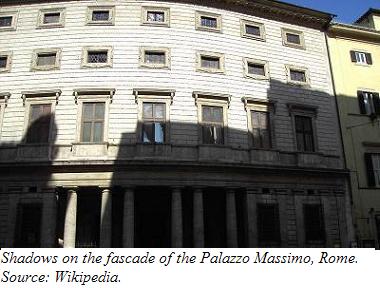 Thomas Kiernan, the Irish Minister to the Holy See, had a beautiful
19-year-old daughter, Blon, who had of course known O’Flaherty forever.
O’Flaherty arranged for her to have a standing invitation to tea at the
German embassy. She would return from the tea parties and report to
O’Flaherty all the small talk made by the German officials. O’Flaherty
would pass this on to Derry, who had four secret radio operators in
contact with British Intelligence. O’Flaherty’s association in this led
to the priest being called in and severely dressed down by his
superiors—not that it had much effect.
Dabbling in intelligence may have caused O’Flaherty trouble otherwise,
too. In 2000, documents surfaced showing that the Nazis had gotten
information from inside the Vatican. O’Flaherty was named as the source
of one report. Since the report was inaccurate—it warned that the
Allies were planning to invade north of Rome, instead of to the south,
as they actually did—it’s possible O’Flaherty was trying to mislead the
Germans. Then, too, the organization got involved with at least two
known double agents, and as American intelligence reports later
revealed, the Gestapo had agents inside the Vatican itself; so it’s also
possible that O’Flaherty didn’t know what he was doing.
Thomas Kiernan, the Irish Minister to the Holy See, had a beautiful
19-year-old daughter, Blon, who had of course known O’Flaherty forever.
O’Flaherty arranged for her to have a standing invitation to tea at the
German embassy. She would return from the tea parties and report to
O’Flaherty all the small talk made by the German officials. O’Flaherty
would pass this on to Derry, who had four secret radio operators in
contact with British Intelligence. O’Flaherty’s association in this led
to the priest being called in and severely dressed down by his
superiors—not that it had much effect.
Dabbling in intelligence may have caused O’Flaherty trouble otherwise,
too. In 2000, documents surfaced showing that the Nazis had gotten
information from inside the Vatican. O’Flaherty was named as the source
of one report. Since the report was inaccurate—it warned that the
Allies were planning to invade north of Rome, instead of to the south,
as they actually did—it’s possible O’Flaherty was trying to mislead the
Germans. Then, too, the organization got involved with at least two
known double agents, and as American intelligence reports later
revealed, the Gestapo had agents inside the Vatican itself; so it’s also
possible that O’Flaherty didn’t know what he was doing. At any rate, it was obvious to everyone that espionage was not O’Flaherty’s forte. His friends sometimes despaired of how open and trusting he was. They were sure Kappler would use it to his advantage. And he tried.
Almost Betrayed.
Kappler managed to capture one of the Italian peasants who brought food and sometimes refugees into Rome. After torture and threats, the man agreed to approach O’Flaherty with a ‘message’ and lure him out of the Vatican into a trap. Just after morning Mass, a Gestapo staff car pulled up to the white line and waited as the unfortunate Italian entered St. Peter’s Square and headed toward the steps, where O’Flaherty was standing with John May. Three times, the peasant circled the Piazza, hesitating whenever he got near the priest. The Germans watched impatiently, O’Flaherty calmly, and May with increasing suspicion. Finally the man gave O’Flaherty one imploring look, and turned and ran down a side street deeper into the Vatican. O’Flaherty wanted to go right after him. May persuaded him to wait in his office until they were sure the man had had a true change of heart. (He had, and of course O’Flaherty made himself responsible for the man’s safety.) O’Flaherty’s colleagues had every reason to be cautious and distrustful. But sometimes the Monsignor’s open-hearted acceptance of every person proved to be wiser. The German soldier who was brought to the Irish Legation one day certainly looked suspicious. The Italian who accompanied him claimed that the soldier had collapsed with exhaustion in the street. When the Italian had stopped to assist him, the soldier explained that he’d gone without food for several days. He was a priest, he said, and was fasting in the hopes that God would give him the opportunity to celebrate Mass. Thomas Kiernan's wife, Delia Murphy, must have had her reservations. But she took the German to O’Flaherty. The Monsignor quizzed the man about the faith, and, satisfied that his claim was genuine, took him to a chapel. “As I watched him slowly mount the steps to God’s altar,” Delia wrote later, “I wondered about the foolishness of war and the sacrifices of life.”The Fearful Days.
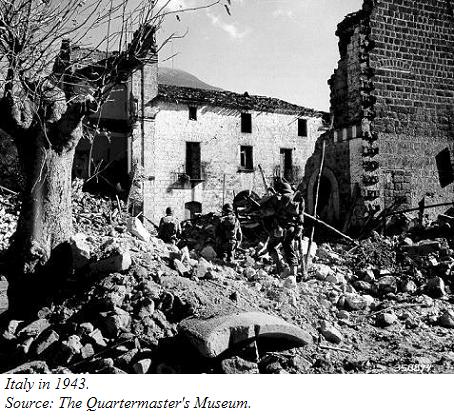 As Christmas 1943 approached, Major Simpson remembered seeing
O’Flaherty’s room “crammed with small parcels, all wrapped in gaily
colored paper and tied with red silk ribbons.” Molly Stanley had
prepared these packages for the refugees, and O’Flaherty was rallying
his fellow priests to help deliver them. The escapees and their hosts
were likewise determined that Christmas would be as merry as they could
make it. Mrs. Chevalier cooked an epic feast. Delia Murphy gave many
impromptu concerts. But on December 27, the “fearful days” began.
The 7 p.m. curfew was strictly enforced, meaning that the organization
had to move refugees around in broad daylight. The easiest gate into
the Vatican was sealed off, forcing all visitors to pass through a
heavily guarded checkpoint. Food was scarce and the rationing system in
chaos. Sometimes the water was shut off, sometimes the electricity.
The Allies landed at Anzio in January, but in Rome, it was Kappler who
seemed to be winning.
As Christmas 1943 approached, Major Simpson remembered seeing
O’Flaherty’s room “crammed with small parcels, all wrapped in gaily
colored paper and tied with red silk ribbons.” Molly Stanley had
prepared these packages for the refugees, and O’Flaherty was rallying
his fellow priests to help deliver them. The escapees and their hosts
were likewise determined that Christmas would be as merry as they could
make it. Mrs. Chevalier cooked an epic feast. Delia Murphy gave many
impromptu concerts. But on December 27, the “fearful days” began.
The 7 p.m. curfew was strictly enforced, meaning that the organization
had to move refugees around in broad daylight. The easiest gate into
the Vatican was sealed off, forcing all visitors to pass through a
heavily guarded checkpoint. Food was scarce and the rationing system in
chaos. Sometimes the water was shut off, sometimes the electricity.
The Allies landed at Anzio in January, but in Rome, it was Kappler who
seemed to be winning.First he arrested 18 Italian padrones. Then he found a young woman involved in the organization and threatened the life of her small child until she agreed to betray several key members. Kappler had SS men pose as escapers on several occasions. Once led to the hideouts and introduced to the padrones, the SS men would pull out guns and place everybody under arrest. From the people captured, Kappler would learn clues that would lead to another raid, on another billet, and more arrests. Each time something like this happened, O’Flaherty and Derry had to abandon the hideouts that had been raided and relocate many of the escapers—always risky. Bruno Buchner, a Yugoslav who had been aiding O’Flaherty since the beginning, was captured, tortured, and having divulged nothing, finally shot. Mrs. Chevalier’s oldest daughter, Gemma, attracted the attention of a plainclothes member of Koch’s police squad one afternoon, and only escaped him by jumping straight across the path of an oncoming trolley. Yet no matter how many people Kappler threatened, arrested, or tortured, he never seemed to get close to O’Flaherty.
Desperate Measures.
By March 1944, Kappler was desperate and frustrated. He ordered two plainclothes SS men to attend Mass at St. Peter’s. At the end of the service, they were to grab O’Flaherty from his post on the basilica steps, and hustle him across the white line, where he would be “shot while escaping.” But John May knew someone who knew someone in the Gestapo’s clerical office, and so got tipped off about the plot. At first, May begged O’Flaherty to disappear for a while. The Monsignor was disinclined: “What, me boy and let them think I am afraid? As long as they don’t use guns I can tackle any two or three of them with ease”. So May made other plans. As Mass ended, the SS men were tapped on the shoulder by four Swiss Guards and firmly escorted past O’Flaherty. Outside, May had arranged for them to run into a group of Yugoslavian refugees who strongly resented what Hitler had done to their homeland. Gallagher writes, “it was a very bruised and battered pair” of SS men who reported failure to Kappler. March also saw the massacre at the Ardeatine Caves, which killed five of
the organization’s members. The only good thing about it was that it
made many Italians more sympathetic to groups like O’Flaherty’s. The
help was needed. Curfew was now 5:30 p.m. and public transportation had
almost completely broken down. Koch’s ‘police force’ roamed the
streets, shooting first and asking questions later. In April, Kappler
got a hold of the teenage son of one of the organization's collaborators
and handed him over to Koch. After torture, the boy revealed many of
the organization’s hideouts, and every refugee in them was taken. By
now, some 40 of the escapers had been recaptured and eight others shot.
But the Allies were pushing at the Gustav line south of Rome. It was
only a matter of time before they reached the city. Even the Germans
knew that.
March also saw the massacre at the Ardeatine Caves, which killed five of
the organization’s members. The only good thing about it was that it
made many Italians more sympathetic to groups like O’Flaherty’s. The
help was needed. Curfew was now 5:30 p.m. and public transportation had
almost completely broken down. Koch’s ‘police force’ roamed the
streets, shooting first and asking questions later. In April, Kappler
got a hold of the teenage son of one of the organization's collaborators
and handed him over to Koch. After torture, the boy revealed many of
the organization’s hideouts, and every refugee in them was taken. By
now, some 40 of the escapers had been recaptured and eight others shot.
But the Allies were pushing at the Gustav line south of Rome. It was
only a matter of time before they reached the city. Even the Germans
knew that.An Unbelievable Request.
One day in late May, O’Flaherty was visited by an unidentified Italian nobleman, who opened the conversation by praising the priest’s bravery and cunning. O’Flaherty waited for the man to get to the point. Finally the nobleman came out with it. He had a message from Pietro Koch, he said. A request. Koch knew the Germans would soon loose power of Rome. He also knew exactly what would happen to him if Italian resistance fighters got their hands on him—probably his own tortures would pale in comparison. Koch was willing to take his chances at getting away. But he could not risk taking his wife and mother with him. And if they were found in Rome, the Italians would see them as convenient scapegoats, and kill them just as easily.So Koch was asking O’Flaherty to smuggle them to safety.
Even O’Flaherty was taken aback. The man who had publicly outlined the tortures he had waiting for the Irish priest was now asking for help? Koch was, of course, ready to bargain. If O’Flaherty would save his family, Koch would make sure that the captured organization members were left behind in Italian prisons and not transported to Germany. And they were left—except for a small group, who were trucked about 14 miles outside the city, and then shot. O’Flaherty, for his part, made arrangements for Koch’s wife and mother to be taken to Naples and sheltered in a convent. The two women ultimately chose not to go, but O’Flaherty had kept his word to the Torturer of Rome.
An Unbelievable Request.
One day in late May, O’Flaherty was visited by an unidentified Italian nobleman, who opened the conversation by praising the priest’s bravery and cunning. O’Flaherty waited for the man to get to the point. Finally the nobleman came out with it. He had a message from Pietro Koch, he said. A request. Koch knew the Germans would soon loose power of Rome. He also knew exactly what would happen to him if Italian resistance fighters got their hands on him—probably his own tortures would pale in comparison. Koch was willing to take his chances at getting away. But he could not risk taking his wife and mother with him. And if they were found in Rome, the Italians would see them as convenient scapegoats, and kill them just as easily.So Koch was asking O’Flaherty to smuggle them to safety.
Even O’Flaherty was taken aback. The man who had publicly outlined the tortures he had waiting for the Irish priest was now asking for help? Koch was, of course, ready to bargain. If O’Flaherty would save his family, Koch would make sure that the captured organization members were left behind in Italian prisons and not transported to Germany. And they were left—except for a small group, who were trucked about 14 miles outside the city, and then shot. O’Flaherty, for his part, made arrangements for Koch’s wife and mother to be taken to Naples and sheltered in a convent. The two women ultimately chose not to go, but O’Flaherty had kept his word to the Torturer of Rome.
Liberation!
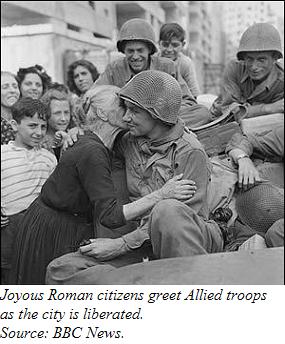 On June 3, Vatican radio picked up a call from a British spearhead
division that had reached the Pope’s summer villa, some 30 km outside of
Rome. Derry radioed back with the military situation of the city.
German troops were simply pulling out. They were still shooting, still
threatening, still stopping citizens and demanding to see identity
papers, but the end was coming.
At 7:15 p.m. on June 4th, the Allies entered Rome. They were greeted by
cheering crowds. Many of the people Kappler had arrested a few months
earlier simple walked out of the prisons. The refugees and their
padrones planned huge parties. Sir D’Arcy, Derry, and John May watched
from the roof as St. Peter’s Square filled with thousands of thankful
people and Pope Pius appeared on his balcony to bless the city. And
O’Flaherty?
On June 3, Vatican radio picked up a call from a British spearhead
division that had reached the Pope’s summer villa, some 30 km outside of
Rome. Derry radioed back with the military situation of the city.
German troops were simply pulling out. They were still shooting, still
threatening, still stopping citizens and demanding to see identity
papers, but the end was coming.
At 7:15 p.m. on June 4th, the Allies entered Rome. They were greeted by
cheering crowds. Many of the people Kappler had arrested a few months
earlier simple walked out of the prisons. The refugees and their
padrones planned huge parties. Sir D’Arcy, Derry, and John May watched
from the roof as St. Peter’s Square filled with thousands of thankful
people and Pope Pius appeared on his balcony to bless the city. And
O’Flaherty? “ ‘Well my lad there is work to be done,’” Sam Derry recalls the Monsignor saying. “And off he went into the City to visit some of our helpers and their relations who had suffered so much as a result of their activities on our behalf. In the evening he was back in the British Legation to see the Minister and myself with a list of requests for immediate action, some of which were not so easy to meet, considering the general chaos in Rome immediately after the liberation.”
To O’Flaherty, the liberation meant only an end to some of the hardships. Victory, triumph, conquest—these things mattered little to him, even if it was he and his friends who could claim them. Sometime in his life, somewhere in his heart, O’Flaherty had made a promise to come to the aid of anyone in need, no matter their nationality, no matter their religion, no matter whose side they were on. Now that the tide of war had turned, it was no longer the Allies and the Jews who needed help; it was the Italian Fascists and the Germans.
The Work Continues.
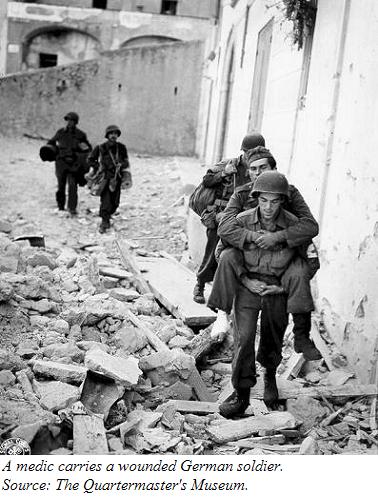 The end of the war was in sight now, and if the rest of the world was
inclined to sit back and relax a little, O’Flaherty was not. He was
soon visiting POW camps again, only this time the prisoners were Italian
and German. Just as he had before, he kept an eye on welfare and
conditions, gathered names, and helped Italian citizens get news of
their missing or imprisoned relatives. Sam Derry arranged for
O’Flaherty to see the US General, Mark Clark, and recalls that the
Monsignor spent most of the meeting quizzing the General about the
Americans’ treatment of their German captives.
O’Flaherty flew to South Africa to visit prison camps there. He visited
Jerusalem to help many of the Jews he had rescued with their
immigration to Israel. The two double agents who had been involved with
the organization were put on trial as Fascist collaborators.
O’Flaherty testified on their behalf. “They did wrong,” he told Derry,
“but there is good in every man.”
The end of the war was in sight now, and if the rest of the world was
inclined to sit back and relax a little, O’Flaherty was not. He was
soon visiting POW camps again, only this time the prisoners were Italian
and German. Just as he had before, he kept an eye on welfare and
conditions, gathered names, and helped Italian citizens get news of
their missing or imprisoned relatives. Sam Derry arranged for
O’Flaherty to see the US General, Mark Clark, and recalls that the
Monsignor spent most of the meeting quizzing the General about the
Americans’ treatment of their German captives.
O’Flaherty flew to South Africa to visit prison camps there. He visited
Jerusalem to help many of the Jews he had rescued with their
immigration to Israel. The two double agents who had been involved with
the organization were put on trial as Fascist collaborators.
O’Flaherty testified on their behalf. “They did wrong,” he told Derry,
“but there is good in every man.” 1946 saw O’Flaherty promoted to a higher position in the Holy Office. But the tales told about his work and the regard with which the people held him (some called him a saint) unfortunately hurt his career more than helped it. Those Vatican officials who had always been annoyed by his unorthodox style were doubly offended now. Even though he never sought recognition, and would get almost angry if called a hero, O’Flaherty had to fight backbiting and politics for the rest of his career. This tired and disappointed him, but he didn’t let it discourage him too badly.
He was busy with other things anyway. After all, the golf courses were open again. While playing near Ciampino one day in ‘46, the monsignor stumbled on a half-starved group of Central European refugees squatting in a ruined village. Naturally O’Flaherty couldn’t just pass by. He provided food and clothing, helped the men find work, fixed up the buildings, taught the refugees about the Church, baptized them, and virtually adopted the whole village. For the next 12 years, he would visit every Sunday and say Mass.
1950 was a Holy Year (a jubilee celebrated by the Catholic Church four times a decade) and hundreds of religious pilgrims were expected to travel to Rome. To help them make the most of their visit, O’Flaherty was asked to co-author a guide to sights of the city. As usual, the Monsignor gave the job his all. The resulting book, O Roma Felix, is described by biographer Brian Fleming as “an amazing amalgam of geography, history, culture and archaeology … a very scholarly work and far richer in its content than the average guidebook.”
O’Flaherty was justly proud of his book, and would tell anyone who asked that it was better than any other guide to Rome. But about his work during the war, he remained reticent. Even his closest family learned about his heroism only indirectly. His sister, Bride, recalled meeting a Jewish family on one of her visits Rome. When they learned that the Monsignor was her brother, they brought her into their jewelry shop and insisted that she pick out anything she wanted, so great was their gratitude to O’Flaherty. But from her brother himself, Bride could rarely get a word.
After the War.
Because of O’Flaherty’s silence, it is hard to know exactly how many people he helped to rescue during the occupation of Rome. According to Sam Derry’s records, the British escape organization saved some 3,925 prisoners-of-war—British, American, Russian, Greek, South African and twenty other nationalities. Major William Simpson, who became closely involved with the work of both Derry and the Monsignor, estimates that around 2,000 civilians were helped as well. For his work, O’Flaherty was made a Commander of the British Empire, and awarded the US Medal of Freedom with Silver Palm. (All such decorations were sent to his sister in Ireland, to be kept in a drawer.) Italy offered him a lifelong pension, but he refused to use it.Sam Derry was given the Distinguished Service Order, and eventually retired a lieutenant-colonel. Mrs. Chevalier received the British Empire Medal, and many other members of the organization were decorated or commended. Gemma Chevalier married a British Corporal, Kenneth Sands; O’Flaherty performed the ceremony.
Pietro Koch escaped Rome but was shot by Italian partisans as he tried to reach Milan. Colonel Herbert Kappler was tried for war crimes and sentenced to life imprisonment. He served his time in Italy’s Gaeta prison, where, for the next decade, he had only one regular visitor.
Monsignor Hugh O’Flaherty came to see him every month.
And in March of 1959, Kappler was baptized into the Catholic Church at the hand of the Irish priest.
The Books.
 Irish newspaperman J.P. Gallagher first heard about Hugh O’Flaherty
while covering the war front, and was largely responsible for bringing
the Monsignor’s story to the attention of the world at large. In one
feature the reporter dubbed O’Flaherty the “Scarlet Pimpernel of the
Vatican,” after the fictional hero of a popular adventure series by
novelist Emma Orczy. The name stuck.
After the war, Gallagher continued to be intrigued by the story. After
much pleading on the reporter’s part, the reluctant Monsignor was
persuaded to give one interview. This, plus much research and many other
interviews with people who knew, helped, or were helped by the priest,
became the basis for Gallagher’s book, Scarlet Pimpernel of the Vatican, published in the late sixties.
Irish newspaperman J.P. Gallagher first heard about Hugh O’Flaherty
while covering the war front, and was largely responsible for bringing
the Monsignor’s story to the attention of the world at large. In one
feature the reporter dubbed O’Flaherty the “Scarlet Pimpernel of the
Vatican,” after the fictional hero of a popular adventure series by
novelist Emma Orczy. The name stuck.
After the war, Gallagher continued to be intrigued by the story. After
much pleading on the reporter’s part, the reluctant Monsignor was
persuaded to give one interview. This, plus much research and many other
interviews with people who knew, helped, or were helped by the priest,
became the basis for Gallagher’s book, Scarlet Pimpernel of the Vatican, published in the late sixties. With true Irish storytelling flair, Gallagher makes Scarlet Pimpernel of the Vatican read like a novel. The book moves chronologically through O’Flaherty’s life, focusing most closely on the war years. The chapters are filled with fascinating anecdotes (who knew that the one of the refugees, a young Yugoslav med student, would end up marrying actress Gina Lollobrigida?). O’Flaherty may come across as larger than life, but he never seems less than real. Any writer knows how hard it is to portray an honestly good person; in this Gallagher has succeeded.
Gallagher does have the attitudes of his era, a definite pro-British slant, and a regrettable tendency to fictionalize dialogue of the “Wait! We kom!” variety for the Germans. But on the whole the book is well-written, fast-paced, and never disappoints. Scarlet Pimpernel of the Vatican is out-of-print now, and a bit hard to find, but if you’re seriously interested in the Monsignor, it’s worth tracking down.
For a long time, Gallagher’s book was the only source of information about Hugh O’Flaherty’s life and career. But the Monsignor’s story has been getting more attention since 2008, when Irish writer Brian Fleming brought out his new biography, The Vatican Pimpernel: The Wartime Exploits of Monsignor Hugh O’Flaherty The publication of this book marks the first serious study of the Monsignor in more than forty years.
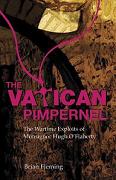 Fleming, a former member of the Oireachtas (Irish Parliament), and
principal at Collinstown Park Community College in Dublin, has done an
excellent job of giving us a contemporary analysis of O’Flaherty’s life.
A great deal of research obviously went into the book, and Fleming has
gotten as close to the original sources as he can in every case. While
the story is basically the same as it is in Gallagher’s book (a tribute
to O’Flaherty’s integrity, really), The Vatican Pimpernel offers us a wealth of new information.
Fleming, a former member of the Oireachtas (Irish Parliament), and
principal at Collinstown Park Community College in Dublin, has done an
excellent job of giving us a contemporary analysis of O’Flaherty’s life.
A great deal of research obviously went into the book, and Fleming has
gotten as close to the original sources as he can in every case. While
the story is basically the same as it is in Gallagher’s book (a tribute
to O’Flaherty’s integrity, really), The Vatican Pimpernel offers us a wealth of new information. Fleming spends some time on the various political situations, expanding the stage on which the story is set. There are several new exploits to be added to the Monsignor's legend, and new details about the old ones. Many characters whose small roles were previously overlooked are now given their due. And we get more of a sense of O'Flaherty himself, as a man and a priest, not just a hero.
The Vatican Pimpernel may not be as sensational as Gallagher’s book, but you will still be absorbed in its pages. Fleming’s straightforward prose sets off the heroism of O’Flaherty and co. with all the simple style of a roman collar. As true-story reading goes, the book is quite enjoyable.



No comments:
Post a Comment